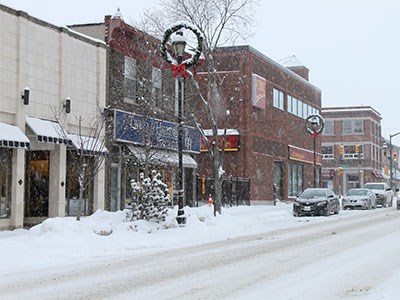Downtown Timmins, the city’s Business Improvement Association (BIA), marked a milestone in mid- December when it finished its five-year strategic plan. But completing it was the easy part.
“We know where we’re going,” said Noella Rinaldo, executive director of Downtown Timmins. “Now we just have to figure out how to get there.”
It’s the first strategic plan the organization’s developed in about eight or nine years, Rinaldo said, and the BIA was to set out guidelines for implementation beginning in January.
To start, the BIA had to decide who its clients were. The organization serves the landlords who own the buildings, because they pay the municipal levy, Rinaldo said, but it also serves the tenants with businesses in those buildings, as well as the public, which feels it has a stake in the future of the downtown.
As a result, the BIA opted to change its mandate to reflect a new goal: making the downtown feel like more like a neighbourhood within the city.
Roughly 3,000 people work in the downtown, which has a vacancy rate of less than 1 per cent. But the perception of what downtown encompasses has changed, Rinaldo said. Retail space has made way for government, medical and banking services, and people often don’t perceive the downtown as having much to offer because there are fewer shopping opportunities.
There’s also the issue of accessibility.
As the province introduces new measures over the next few years, offices located on upper levels of buildings have to be made fully accessible, Rinaldo said. Many landlords are opting to turn offices into residential space in lieu of installing elevators, which can be costly and disruptive.
Many businesses are still interested in being located, downtown, however, and Rinaldo said landlords are taking note.
Some are converting their mid-sized offices into smaller, hub-type offices that can accommodate several small businesses or organizations. A trio of independent law offices took this idea and ran with it when they rented communal space for a shared reception area and secretary, while maintaining separate practices.
In many cases, the phone and computer lines are already set up, and the space is ready as a turnkey operation.
“You don’t need very much anymore,” Rinaldo said. “Gone are the days of the big file cabinets. You bring your laptop and plug it in, and if you’re a small bookkeeper and you don’t want them coming in your house, this is an affordable way. Bring your laptop, plug it in, and you can meet your client there.”
Once downtown, people need things to do to keep their interest.
The BIA is continuing to develop its urban park, which was established three years ago. The BIA closes off city streets, setting out patio tables and chairs and encouraging people to remain downtown and explore what there is to offer.
“One of the problems in this downtown is we don’t have a focal point,” Rinaldo said. “We don’t have a square, or a park. We don’t have anywhere to really focus or to have events or anything, so we close off the streets in the summer and we take over the streets.”
Wednesdays feature a market for crafters and artisans, while Thursdays are reserved for a farmers’ market. Last summer, the BIA experimented with having music on Fridays. It worked so well, the organization will continue with it this summer, Rinaldo said. Events will be complemented by an ongoing beautification project that will introduce flower pots to the streets.
Over the longer term, Rinaldo wants to bring more services to the downtown.
Right now, the downtown is lacking restaurants and a grocery store, and she’d love to see a department store in the style of Giant Tiger.
Whatever comes downtown, Rinaldo said the BIA needs to be strategic in its attraction of new activities, focusing on sustainable events that have a longer impact than just an immediate boost.
“I think you have to be really careful of what kind of events you bring downtown— why are you doing it?” she said. “I think it’s always to give exposure to your businesses.”




